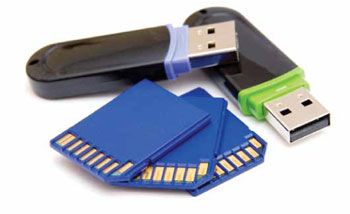
In A Flash
Flash memory delivers performance benefits to video storage, but at what cost?
- By Lee Caswell
- Apr 01, 2012
Surveillance data is critical in applications ranging from retail to government, and gaming to transportation. Today, video usage is moving beyond security and safety to other key business functions such as training, staffing, marketing and traffic flow. The strategic value of video data is made possible because of advancements in IP-based megapixel cameras and the intelligence of incoming video streams, which are increasingly tagged with information to improve search capabilities. But the influx in high-resolution video data combined with the greater amount of VMS features creates a significant performance challenge for video surveillance storage systems, which are the core of any surveillance deployment. Flash memory is a compelling new high-performance storage technology, but the price premium over disk drives is so large that it takes some creative thinking to make flash costeffective for mainstream surveillance environments.

The impact of high-resolution cameras on video storage systems is dramatic. The improved clarity and analytic capabilities so valued by security practitioners place a heavy load on the slowest component in the system—the disk drive. Similarly, tagging video with attributes such as location, time, GPS, color or motion increases the size of incoming data streams that must be captured and stored in real time.
All of this new functionality requires an innovative approach to meet the manageability, performance and cost expectations of the video surveillance market. As more security systems embrace IP infrastructure, storage vendors are incorporating more functionality in appliances to enable scalability, simplicity, and immediate and long-term savings. Today, there is a new focus on bringing technologies commonly seen in consumer-based technologies to the surveillance market to increase performance and reliability. Flash memory is one of the technologies that can benefit the market, but many see this option as cost-prohibitive for today’s budget-conscious user. In this article, we look at the pluses and minuses of flash storage and how unique approaches to the technology can boost performance when used in specific security applications.
Flash Gains Traction
You may not be aware, but flash memory is everywhere. Flash memory products are found in iPods, digital cameras, thumb drives and even game consoles, such as Wii. The technology has helped increase the development and adoption of portable devices, and it is likely to become only more affordable and better performing as time passes.
Even so, flash technology is only just beginning to be used in the security and video surveillance markets, and it is used only in limited technologies, most of which are new and unique innovations. Flash brings a variety of benefits to the consumer market, but what benefits can it bring to surveillance? What is it about flash memory that makes the technology attractive, and how can it be deployed to meet the specific needs of video surveillance users?
Strength in Speed
With the name “flash,” you would expect that this chip-based storage technology is fast. And you’d be right; it is. Flash memory can be more than 100 times faster than familiar disk drives. Read and write times vary by device, but flash is especially effective when it eliminates the spin-up time of traditional mechanical disks.
Flash-based technologies deliver other benefits, as well. These solid-state devices eliminate the mechanical frailties of a disk drive spinning at thousands of revolutions per minute (rpms). Therefore, they are less likely to break when a user drops or damages the units. Flash devices are also quite quiet, which is a change from traditional spinning drives that can make quite a racket.
Considering the benefits of flash memory, the question becomes, why haven’t flash devices replaced disk drives entirely in surveillance? The answer lies in the wide disparity of cost and the difference in reliability between the two technologies.
Comparison Points
First, the price difference between flash memory devices and traditional disk-based storage is startling. A 1-TB SATA drive costs approximately $100 while a 1-TB flash drive appropriate for video surveillance is 10 to 50 times more expensive. That means 1 TB of flash can cost between $1,000 and $5,000, a substantial increase that would scare off most budget-conscious customers. Overall, that storage cost premium would add more than $500,000 to the budget of a mid-size airport installation, for example. Therefore, because of economics and budgetary needs, it is clear that flash will not be selected, or demanded, as the primary storage technology for a large-scale surveillance deployment.
While it is expected that flash devices will decrease in cost over time, disk drives will similarly drop in cost, and the delta between the technologies will remain through the end of the decade. As a result, disk drives will continue to be the primary storage solution for the huge files generated by today’s highresolution, IP-based surveillance cameras that are commonly being used in large-scale surveillance systems.
Flash on Board
Now, if a customer requires only a small amount of capacity, then a single flash chip could be an attractive option. This is why surveillance camera manufacturers are adding SD card slots— on-board storage—in particular camera models: to locally store video in distributed environments with limited retention times. We’ve seen an influx in cameras with on-board SD storage in the last year, and this is predominately due to the cost benefit. A 32 GB flash card, for example, costs approximately $40 and can store about a week’s worth of video at fairly low resolution and frame rates. Altogether, adding SD cards to 100 cameras would cost about $4,000.
There are some downsides to camera-based flash cards. The camera—and the video on the camera’s flash card—is a single point of failure that is easily subject to loss, theft or vandalism, leaving video data unprotected and at risk. Because of the risks associated with video and equipment loss, this design simply does not work for installations where video is critical for liability or regulatory issues, or those located in high-risk areas. The critical importance of video data demands that video is available at all times, and it is paramount that mission-critical systems run 24/7 and maintain a high level of performance.
With this in mind, flash attached to cameras seems more suited to small installations with limited liability exposure.
The newest idea for applying flash technology to video surveillance is to place small amounts of it as a disk drive accelerator so that more high-resolution camera channels and more tagged video can be supported with the slowest, most inexpensive disks.
The blending of flash memory for speed and spinning disk storage for economics has been difficult to achieve in the past because conventional IT storage systems required huge amounts of flash to keep up with dense, incoming video streams.
The solution is to introduce small amounts of flash in storage appliances and then scale up both the flash and the disk as additional channels are added or additional capacity is needed. By aggregating the expensive flash memory across multiple appliances, it can be cost effectively added into a surveillance system to improve performance while increasing the cost only slightly.
Many users think of video feeds as streaming and sequential. But new video tagging data—also known as video intelligence— introduces non-sequential information that is difficult for slow-spinning disks to accommodate. As video management software introduces new features and capabilities, the support for tagging video can be sped up dramatically with a discriminating use of flash. The Pivot3 vSTAC Watch appliances, for example, are the first video surveillance storage products to include 200 GB of flash memory with each appliance. The ratio of flash to disk capacity is less than 1 percent, but the write performance for latency-sensitive operations improves by 10 times.
Flash Forward
As video surveillance has changed, video storage systems have changed to meet the needs of the surveillance user. Over the past 20 years, tape systems gave way to disk-based systems. Then stand-alone DVRs migrated to RAID-protected NVRs. Recently, shared storage and even virtualization technologies are making their way to the mainstream. Flash technology is the latest example of how a technology widely used outside of surveillance can be deployed in a custom way to meet the specific needs of the surveillance user, whether applied to cameras or high-end storage systems. Users must look closely at their specific needs to see how flash can benefit their environments.
Product manufacturers will similarly need to look at how new applications of flash memory can improve their offerings to best maintain valuable video evidence that helps security end users reduce fraud and criminal activity.
This article originally appeared in the April 2012 issue of Security Today.
About the Author
Lee Caswell is the co-founder and
chief marketing officer of Pivot3.